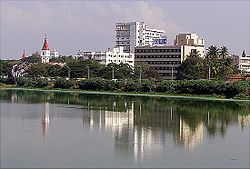 Archaeological data from Kodumanal, a village on the banks of the Noyyal River, suggests the beginning of civilization around 4th century BCE. Kodumanal was situated on the ancient trade route between across the Palghat gap in the Western Ghats and yielded remains belonging to the Sangam age. Tamil-Brahmi writings were found on coins, seals and rings obtained from Amaravathi river bed near Karur, the erstwhile capital of the Cheras. A musical inscription in Tamil Brahimi was found in a cave in Arachalur, dating from the 4th Century CE and Iravatham Mahadevan writes that these are syllables used in dance.
Archaeological data from Kodumanal, a village on the banks of the Noyyal River, suggests the beginning of civilization around 4th century BCE. Kodumanal was situated on the ancient trade route between across the Palghat gap in the Western Ghats and yielded remains belonging to the Sangam age. Tamil-Brahmi writings were found on coins, seals and rings obtained from Amaravathi river bed near Karur, the erstwhile capital of the Cheras. A musical inscription in Tamil Brahimi was found in a cave in Arachalur, dating from the 4th Century CE and Iravatham Mahadevan writes that these are syllables used in dance.
The region was ruled by the Cheras during Sangam period between c. 1st and the 4th centuries CE and the medieval Cholas conquered the Kongu Nadu in the 10th century CE. Much of Tamil Nadu came under the rule of the Vijayanagara Empire by the 15th century. In the 1550s, Madurai Nayaks, who were the military governors of the Vijayanagara Empire, took control of the region. After the Vijayanagara Empire fell in the 17th century, the Madurai Nayaks established their state as an independent kingdom. They introduced the Palayakkarar system under which Kongu Nadu region was divided into 24 Palayams. In the latter part of the 18th century, the region came under the Kingdom of Mysore, following a series of wars with the Madurai Nayak dynasty. After the defeat of Tipu Sultan in the Anglo-Mysore Wars, the British East India Company annexed the region to the Madras Presidency in 1799. The region played a prominent role in the Second Poligar War (1801), when it was the area of operations of Dheeran Chinnamalai. Influence of Jainism is also evident in certain parts of the region.

Recent Comments